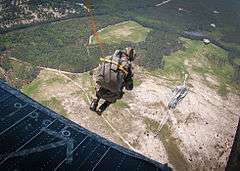50th Parachute Brigade (India)
| 50th Indian Parachute Brigade 50 (Independent) Parachute Brigade | |
|---|---|
| Active | 1941–present |
| Country |
|
| Branch |
|
| Type | Airborne forces |
| Role | Parachute infantry |
| Size | Brigade |
| Garrison/HQ | Agra |
| Engagements |
Burma Campaign 1961 Indian Annexation of Goa |


The 50th Parachute Brigade is a brigade-sized formation of the Indian Army, first formed in 1941. The brigade was initially raised as part of the Indian Army during World War II. It was formed in October 1941, during the Second World War, as an independent parachute brigade. Later it was one of two parachute brigades in the 44th Indian Airborne Division. Its main force is formed of battalions of the Parachute Regiment, which became the Parachute Regiment (India) after Indian independence in 1947.
The brigade's initial composition included 151st British Parachute Battalion, 152nd Indian Parachute Battalion, and 153rd Gurkha Parachute Battalion. When the British battalion was recalled to the United Kingdom, it was replaced by a 154th Gurkha Parachute Battalion. Other components of the brigade included 411th (Royal Bombay) Parachute Squadron, Indian Engineers and 50th Medium Machine Gun Company. The brigade took part in the Battle of Sangshak, which has been credited with delaying the Japanese forces moving up for the Battle of Imphal which allowed British and Indian reinforcement to reach Kohima.
Goa 1961
The brigade took part in the 1961 Indian Annexation of Goa along with 17th Indian Infantry Division. Although the 50 Para Brigade was charged with merely assisting the main thrust conducted by the 17th Division, its units moved rapidly across minefields, roadblocks and four riverine obstacles to be the first to reach Panjim.[1]
On the morning of 18 December, the 50 Para Brigade moved into Goa in three columns.
- The eastern column comprised the 2nd Para Maratha advanced via the town of Ponda in central Goa.
- The central column consisting of the 1st Para Punjab advanced via the village of Banastari.
- The western column - the main thrust of the attack - comprised the 2nd Sikh Light Infantry as well as an armored division which crossed the border at 0630 hours in the morning and advanced along Tivim.
The western column, facing no resistance, reached the town of Betim at 1700 hours, just a 500 metre wide river crossing away from Panjim, the capital town. In the absence of orders, the units set camp at Betim and proceeded to secure areas up and down the riverfront.
The order to cross the river was received on the morning of 19 December, upon which two rifle companies advanced on Panjim at 0730 hours and secured the town without facing any resistance. On orders from Brigadier Sagat Singh, the troops entering Panjim removed their steel helmets and donned the Parachute Regiment’s maroon berets. As the men marched into the town, they were welcomed as liberators by the locals.
Twenty-first Century
In the 21st century the 50th (Independent) Parachute Brigade comprises two parachute battalions, one special forces battalion, 60 Parachute Field Ambulance, 411 (Independent) Parachute Field Company (Bombay Sappers), 622 Parachute Composite Company ASC, 50th (Independent) Parachute Brigade OFP (Ordnance), 50th (Independent) Parachute Brigade Signal Company, 2 (Independent) Parachute Field Workshop Company, 1 parachute field regiment (Artillery) (9 & 17 parachute field regiments) and a provost section, an air defence battery. The President's Bodyguard also forms part of the brigade as the pathfinder company.
The three parachute battalions in rotation form part of the parachute brigade alternatingly serving their field tenures in counter-insurgency/high altitude areas. One of the eight SF battalions too serves in the brigade on rotation. One of the two field regiments (9 Para Field Regiment and 17 Para Field Regiment, Regiment of Artillery) also forms part of the brigade while the other serves out its field tenure on rotation.